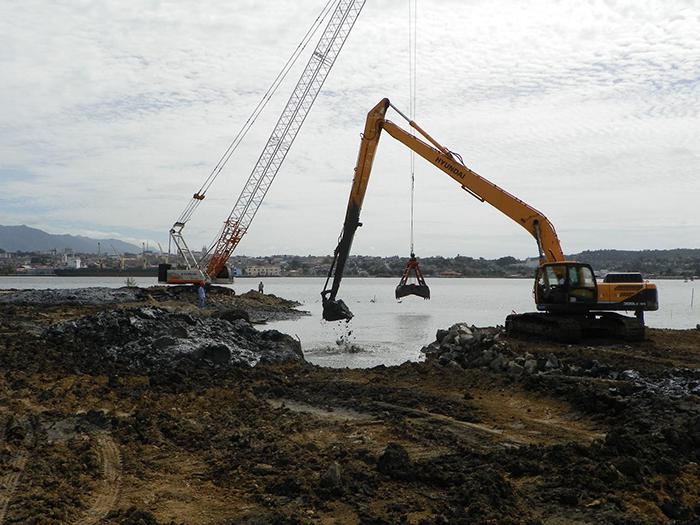
SANTIAGO DE CUBA.— Considered the launch of the progressive modernization of the Guillermón Moncada port, the Cuba-China cooperation project for the construction of the Yarayó multipurpose terminal is currently in a decisive phase. Innovative ground improvement works to prepare the construction site are currently being undertaken as part of the intensification of works in this important investment project.
Despite being the second most important port in the country, Santiago has among its limitations a depth that only allows vessels of between 5,000 and 15,000 tons to access its three docks, notable technological obsolescence including a lack of gantry cranes, and insufficient warehouse capacity.
According to the young engineer Walter Niuvó Medina, director of the basic enterprise unit, the works are based on Guideline no.275 of the Economic and Social Policy Guidelines of the Party and the Revolution, approved at the 7th Party Congress, which outlines the gradual development of port infrastructure to allow for a reduction in freight rates.
Plans are to provide the port with a modern facility, to receive ships of 20,000 - 40,000 tons, to be operated by state-of-the-art technological equipment, both for the docking and unloading of goods.
For ships with such characteristics, the project includes a dock measuring 231 meters in length, with a depth of 13.60 meters, two warehouses with capacity for 2,040 tons of general cargo and 10,080 of dry cargo, two 30 and 50 ton multipurpose cranes, and eight light towers to facilitate 24 hour operations.
Groundworks are currently underway across an area of 59,878 square meters, scheduled to conclude in June next year. The site preparation will increase resistance and substantially improve drainage in a flood-prone area in the event of heavy rains or big waves.
Given the cost of removing and replacing a high volume of earth, Chinese engineer Hu Xiao Yuan, leading production manager of the construction, explained that alternatives widely used in his own country and other parts of the world, with optimal results, will be used in Cuba for the first time.
He detailed that following the clearing of the area, more than 170 cubic meters of fill material will be placed, including 50,000 cubic meters of sand to provide a layer with a thickness of 80 centimeters, and a layer of gravel requiring 32,000 cubic meters of the material.
In addition, 444,000 linear meters of plastic wick drains and 56,000 square meters of geotextile fabric will be laid to enhance soil sustainability. Likewise, 142 concrete piles will be driven into the ground, and once completed high tension tests will be carried out on the area to be occupied by the dock.
With works advancing on schedule, the dredging of the seabed is currently underway at the docking site, where following the excavation works, a protective layer of 160,000 cubic meters or rock will be placed on both sides of the dock to improve safety.
According to Huang Jin Long, chief engineer of the China Communications Construction Company Ltd (CCCC), in charge of the investment project, “The quality of works by Santiago construction workers stands out, as a reflection of their high training and the close relations established.”
Once this essential process is completed, works will accelerate with equally modern technologies in the construction of warehouses, roads, and the 25 other facilities, including the dock, for which a concrete mixing plant was installed to provide the over 8,000 cubic meters required over three months in its construction.
Among other temporary facilities, offices, accommodation, plumbing and electrical networks, slabs for forming steel elements, the abovementioned concrete plant and cement silos, machinery, heavy equipment, and the organization and preparation of all exterior areas, can currently be observed at the site.
According to information provided by the Deputy Director of the port of Santiago, Mario Sierra Osorio, once the terminal begins operations, it could result in a reduction of 50% in the time currently required for unloading, which every four years would produce 1.4 million dollars of savings for the island.
The new terminal, designed with an annual operating capacity of 565,000 metric tons, including general goods, containers, and bulk cargo, will undoubtedly mean that the 412 consigned vessels shipping one million metric tons of goods to the island this year will be surpassed.
The modernization of the port of Santiago will be later accompanied by the transformation of the entire railway and road infrastructure in eastern Cuba, as well as facilities associated with tourism, which, in addition to the economic impact, will have a social impact across the region.















